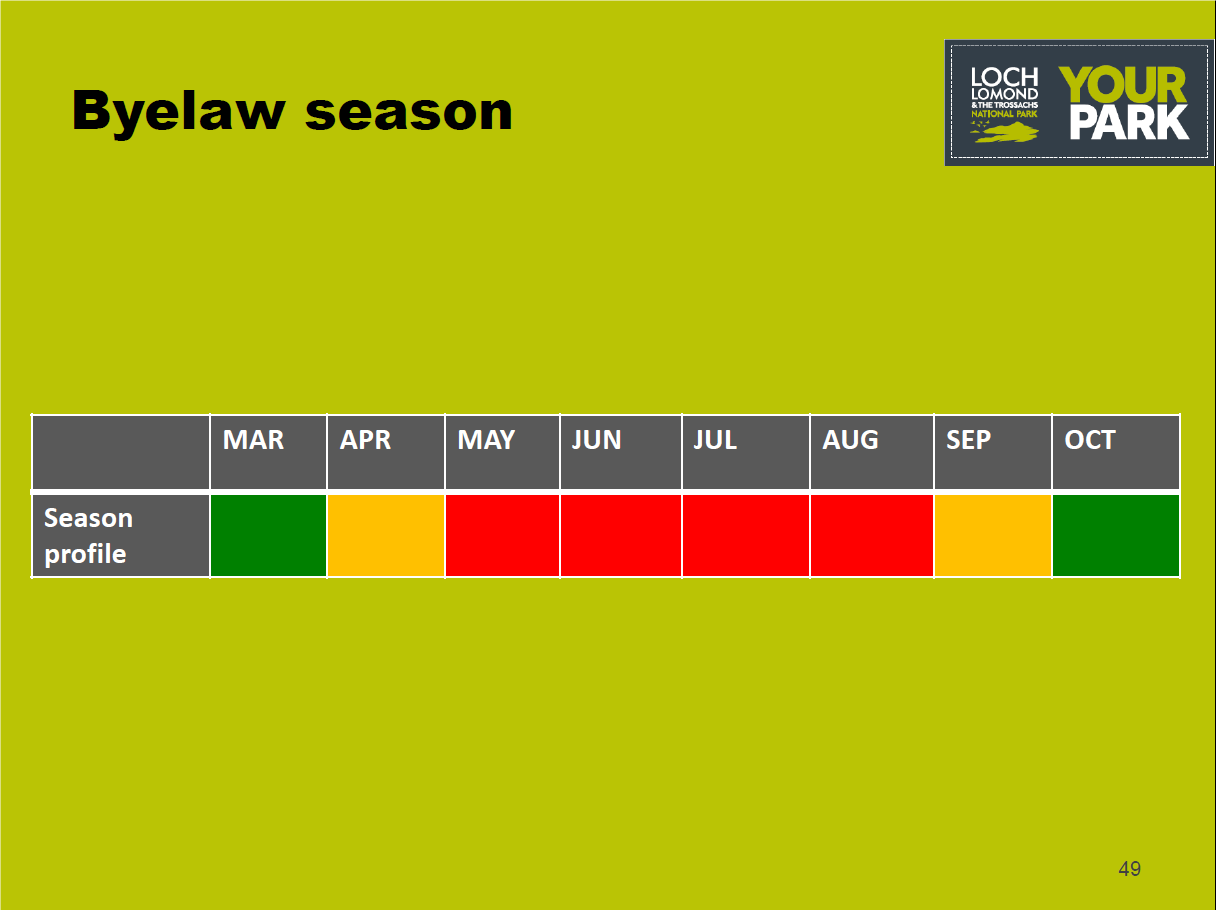
This slide provides a crude summary of the Park’s data on camping activity within the four proposed management zones. Its not surprising, its what anyone who camps or goes to the countryside knows, most camping takes place in summer (despite the midges!). It raises though serious questions about why the The Loch Lomond and Trossachs National Park Authority recommended the camping byelaws should extend from 1st March to 31st October and then why Aileen McLeod, Environment Minister at the time, modified this recommendation so the proposed byelaws will now run from 1st March to 30th September.
The first thing to say is that the slide demonstrates that the main justifications the LLTNPA is now citing for the proposed byelaws, a) the sheer number of campers and b) environmental damage, do not justify the period of the proposed byelaws. While the number of campers represented by each colour in the chart is not defined in the slides (again this is typical for the Park, this is not evidence that would stand up in a court of law), if they were they would show that the number of campers in the green months are very low and in the orange months low compared to the summer period. So, even if one accepts the argument that byelaws are needed to limit the number of campers, the LLTNPA has no evidence that, outwith the four summer months, numbers are a problem or need to be regulated .
Related to this, unless a far higher proportion of campers outwith the summer months behave irresponsibly, the impact of irresponsible behaviour when it occurs will be much less March-April and September-October and is much easier to manage. In visitor management terms, if an occasional abandoned campsite has to be cleared up, so what? There is only a problem if lots and lots of tents are abandoned and are beyond the capacity of the Ranger service and other services to cope with. (The LLTNPA incidentally has never provided any evidence that this actually happens or assessed this problem relative to other litter, such as that washed up at the head of Loch Long after storms). Actually, I believe the proportion of people camping responsibly outwith the summer months is likely to be higher, as people camping at these times are more likely to be dedicated to pursuing their chosen activity and such people are generally more aware of their impacts on the environment.
What this slide shows therefore is that the LLTNPA’s recommendations to Ministers about the byelaw periods was not based on any evidence worth the name but rather on something else. While there are a number of possible explanations, I believe NIMBYISM – which is of course totally contrary to access rights – is at the heart of this.
When I learned that Scottish Ministers had decided to reduce the proposed period of the byelaws from 1st March – 30th September I asked them on what grounds they had done this. I received this reply on 29th April:
Question Four
The decision taken to reduce the period of operation of the byelaws by 1 month was a policy decision taken by Ministers in line with their options to approve, approve with modifications or reject the byelaw proposals submitted by the National Park Authority. While the National Park Authority’s preference was for the byelaws to be in place between 1 March to 31 October as per the operation of the existing East Loch Lomond byelaws, Ministers decided that in approving the new measures they wished to see a reduction in the period of operation by 1 month across all the proposed zones, including those operating in East Loch Lomond. This decision was based on a view that visits to the National Park and the affected areas naturally start to tail off in October, in part due to falling overnight temperatures.
This simply provides further evidence of the arbitrary decision making. The Minister has NO evidence that numbers are less in October than March – indeed the opposite is probably the case because of the fishing season – and as for the claim that October is colder than March this is MINCE! The official who wrote this did not even think it worth consulting the records of the Met: March is significantly colder than October.
What worries me most about the whole camping byelaw farce is that none of it is based on any evidence that would stand up in court. What a contrast to the levels of evidence Ministers demand before agreeing to protect mountain hares or cull red deer.
